การเปรียบเทียบปัจจัยทางประชากรศาสตร์และสุขภาพจิตเชิงบวกของนักศึกษาที่มีความหลากหลายทางเพศ
Main Article Content
บทคัดย่อ
การศึกษานี้มีวัตถุประสงค์เพื่อ 1) ศึกษาสุขภาพจิตเชิงบวกของนักศึกษาที่มีความหลากหลายทางเพศ และ 2) เปรียบเทียบปัจจัยทางประชากรศาสตร์และสุขภาพจิตเชิงบวกของนักศึกษาที่มีความหลากหลายทางเพศ งานวิจัยนี้เป็นงานวิจัยเชิงปริมาณแบบเชิงสำรวจ กลุ่มตัวอย่างคือนักศึกษาที่มีความหลากหลายทางเพศที่กำลังศึกษาอยู่ในมหาวิทยาลัยภาครัฐ กรุงเทพมหานครจำนวน 400 คน เก็บข้อมูลด้วยแบบสอบถามสุขภาพจิตเชิงบวกโดยมีค่าความเชื่อมั่นเท่ากับ 0.96 และวิเคราะห์ข้อมูลโดยใช้สถิติเชิงพรรณนา ค่าสถิติที
(t-test) และ ความแปรปรวนทางเดียว (one-way Anova) ผลการศึกษาพบว่า นักศึกษาที่มีความหลากหลายทางเพศมีสุขภาพจิตเชิงบวกโดยรวมและรายด้านอยู่ในระดับมากโดยด้านที่มีค่าเฉลี่ยสูงที่สุด ได้แก่ การเห็นคุณค่าในตนเอง (M=4.19, SD= 0.63) การยอมรับตนเอง (M =4.16, SD= 0.50) และความสัมพันธ์ระหว่างบุคคล (M=4.05, SD= 0.61) เมื่อเปรียบเทียบตามปัจจัยทางประชากรศาสตร์ พบว่า นักศึกษาชายมีสุขภาพจิตเชิงบวกสูงกว่านักศึกษาหญิงอย่างมีนัยสำคัญทางสถิติ (t = 6.753, p < .05) และนักศึกษาที่มีอัตลักษณ์ทางเพศแบบชายรักชายมีสุขภาพจิตเชิงบวกสูงกว่ากลุ่มอื่นๆ อย่างมีนัยสำคัญทางสถิติที่ .05 ผลการวิจัยนี้ให้ข้อมูลพื้นฐานเกี่ยวกับสุขภาพจิตเชิงบวกของนักศึกษาที่มีความหลากหลายทางเพศและชี้ให้เห็นแนวทางในการวิจัยและพัฒนาการส่งเสริมสุขภาพจิตให้แก่นักศึกษากลุ่มนี้ต่อไป
Article Details

อนุญาตภายใต้เงื่อนไข Creative Commons Attribution-NonCommercial-NoDerivatives 4.0 International License.
เอกสารอ้างอิง
ธนาวุฒิ สิงห์สถิต (2565). สุขภาพจิตและความหลากหลายทางเพศของนิสิตปริญญาตรีชั้นปีที่ 1 (วิทยานิพนธ์วิทยาศาสตรมหาบัณฑิต). จุฬาลงกรณ์มหาวิทยาลัย.
สำนักงานปลัดกระทรวงอุดมศึกษา วิทยาศาสตร์ วิจัยและนวัตกรม. (2565) ข้อมูลนักศึกษา. สืบค้นเมื่อ 8 กุมภาพันธ์ 2565, จาก https://info.mhesi.go.th/homestat_std.php
Bissonette, D., & Szymanski, D. M. (2019). Minority stress and LGBQ college students' depression: Roles of peer group and involvement. Psychology of Sexual Orientation and Gender Diversity, 6(3), 308-317.
Borgogna, N. C., et al. (2019). Anxiety and depression across gender and sexual minorities: Implications for transgender, gender nonconforming, pansexual, demisexual, asexual, queer, and questioning individuals. Psychology of Sexual Orientation and Gender Diversity, 6(1), 54-63.
Brockelman, K. F., & Scheyett, A. M. (2015). Faculty perceptions of accommodations, strategies, and psychiatric advance directives for university students with mental illnesses. Psychiatric Rehabilitation Journal, 38(4), 342-348.
Camp, J., Vitoratou, S., & Rimes, K. A. (2020). LGBQ+ self-acceptance and its relationship with minority stressors and mental health: A systematic literature review. Archives of Sexual Behavior, 49(7), 2353-2373.
Charles, S. T., Karnaze, M. M., & Leslie, F. M. (2022). Positive factors related to graduate student mental health. Journal of American College Health, 70(6), 1858-1866.
Cleofas, J. V. (2023). Communal and national resilience as predictors of happiness among young Filipino LGBTQ+ undergraduates: The mediating role of mental well-being. Journal of Human Behavior in the Social Environment,1, 1-17.
De, L.J., et al. (2022). Minority stress and suicidal ideation and suicide attempts among LGBT adolescents and young adults: A meta-analysis. LGBT Health, 9(4), 222-237.
Jahoda, M. (1958). Current concepts of positive mental health. New York: Basic Books.
Kamen, C. S., et al. (2019). "Treat us with dignity": A qualitative study of the experiences and recommendations of lesbian, gay, bisexual, transgender, and queer (LGBTQ) patients with cancer. Supportive Care in Cancer, 27(7), 2525-2532.
Li, H., et al. (2023). Minority stress, social support and mental health among lesbian, gay, and bisexual college students in China: A moderated mediation analysis. BMC Psychiatry, 23(1), 746.
Lluch, M. T. (2003). Construcción y análisis psicométrico de un cuestionario para evaluar la salud mental positiva. Psicología Conductual. Revista Internacional de Psicología Clínica y de la Salud, 11, 61-78.
McDermott, E., et al. (2023). Understanding how school-based interventions can tackle LGBTQ+ youth mental health inequality: A realist approach. International Journal of Environmental Research and Public Health, 20(5), 4274.
Maslow, A. H. (1943). A theory of human motivation. Psychological Review, 50(4), 370–396
Meyer, I. H. (2003). Prejudice, social stress, and mental health in lesbian, gay, and bisexual populations: Conceptual issues and research evidence. Psychological Bulletin, 129(5), 674-697.
Parchem, B., et al. (2024). Comparison of anxiety and depression rates among LGBTQ college students before and during the COVID-19 pandemic. Journal of American College Health, 72(1), 31-39.
Teixeira, S., et al. (2022). Positive mental health in university students and its relations with psychological vulnerability, mental health literacy, and sociodemographic characteristics: A descriptive correlational study. International Journal of Environmental Research and Public Health, 19(6), 3185.
Travers, Á., et al. (2020). Lesbian, gay or bisexual identity as a risk factor for trauma and mental health problems in Northern Irish students and the protective role of social support. European Journal of Psychotraumatology, 11(1), 1708144.
Vaingankar, J. A., et al. (2013). Socio-demographic correlates of positive mental health and differences by depression and anxiety in an Asian community sample. Annals of the Academy of Medicine, Singapore, 42(10), 514-523.
Woodford, M. R., et al. (2018). Depression and attempted suicide among LGBTQ college students: Fostering resilience to the effects of heterosexism and cisgenderism on campus. Journal of College Student Development, 59(4), 421-438.
Yamane, T. (1967). Statistics: An introductory analysis (2nd ed.). New York: Harper and Row.


